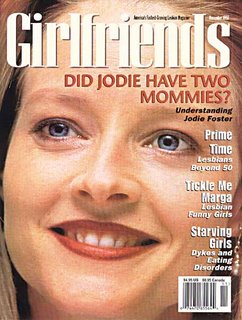Today’s Guest: Heather Findlay, editor of Girlfriends magazine.
 Originally published December 2, 1996
Originally published December 2, 1996
Just because Girlfriends is a magazine for lesbians, don’t assume everyone who works there is on their team.
“We have bisexuals in the office,” notes editor-in-chief Heather Findlay rather brightly. “And we employed a straight over the summer! It’s not a job requirement to be a lesbian to
work at Girlfriends.”
Talk about an equal opportunity employer — even the publisher is straight! Of course, she’s Findlay’s mother, Erin.
“At least I think she would ID as straight,” Findlay says with a laugh.
As one might imagine, this is not the typical parent/child work relationship. When Findlay and several co-workers left the infamous lesbian erotic magazine On Our Backs to launch Girlfriends two years ago, her mom became one of its major investors and accepted the title of publisher. It’s a long way from the day, 10 years ago, when 23-year-old Heather came
out to her family.
“My mother was great, hilarious, actually,” Findlay says. “When I told her, she went through all the homophobic parental reactions in five minutes — ‘I’ll never have grandchildren! I should have let you wear makeup sooner!’ — and then she was over it. Now she feels a real responsibility to be a role model. She even marches with me every year in the Lesbian & Gay Pride Parade here in San Francisco.”
This unique mother/daughter relationship is just a small part of what makes Girlfriends stand out among the many gay and lesbian magazines now crowding the newsstands. More important to readers is the magazine’s vibrant graphics and its bright and smarmy editorial spirit. It’s an enlightening, invigorating magazine whether you’re a lesbian or not.
Girlfriends balances a strong sense of community — profiling political and social leaders — with an element of whimsy, such as its guessing games about the sexual orientation of celebrities.
“I think Girlfriends has taken a really playful and risky line on that,” Findlay says. “We include people who just dress butch. None of our readers has complained, and we haven’t gotten calls from the people in those columns, either. I think we’re still too small for these celebs to care if we publish rumors.”
In its first issue following a complete redesign this past summer, Girlfriends put a happy-go-lucky Whitney Houston on the cover with the headline, “HOUSTON, We Have a Problem: Ten Tips for Whitney on Playing It Straight.”
In a subsequent issue, Girlfriends noodled over the sexual orientation of Vanna White (“Wheel of Fortune”), Christine Elise (“ER”), Kristi Swanson (Buffy the Vampire Slayer), Ellen Barkin (Switch) and Queen Latifah (“Living Single”).
The sexual content of Girlfriends is nowhere near as bold as it was when she was the editor of On Our Backs, which also launched the career of that magazine’s first editor, Suzie Bright, as a national expert on sexuality.
Findlay is somewhat embarrassed by her own magazine’s conservatism; it recently discontinued the practice of publishing centerfolds in copies sold on the newsstand. Only subscribers receive the fold-outs, which feature women who rival or exceed any Playboy gatefold in femininity and beauty.
She says the move away from overt pictorials was necessary for Girlfriends to grow beyond its San Francisco roots. Sexually oriented ads were also relegated to the back of the magazine, much as they are in Playboy and Penthouse.
“We wanted to keep some of the independence and verve of On Our Backs,” she says. “But we also wanted a magazine that a lesbian in Duluth would want to read. On Our Backs reflected the sex-radical scene in San Francisco. It was fascinating but unidentifiable for 95 percent of the lesbian market.”
Girlfriends is succeeding in the battle for the hearts and minds of lesbians, turning a profit this month after less than two years of publication. It has even attracted national liquor advertisers such as Budweiser and Stolichnaya. Even better for Findlay, success has given her the resources to buy On Our Backs out of bankruptcy.
“I have plans to republish it in 1998,” she says. “It’ll be part of turning my company into a multi-title publishing company.”
A Girlfriends World Wide Web site makes the magazine’s content available to an even wider audience, although Findlay wonders if it’s the right audience.
“My biggest fear is that 75 percent of them are guys who type in the word ‘lesbian’ on Yahoo,” she says, only half- joking.

>
 The Party Authority in New Jersey, Pennsylvania, Delaware and Maryland!
The Party Authority in New Jersey, Pennsylvania, Delaware and Maryland!
